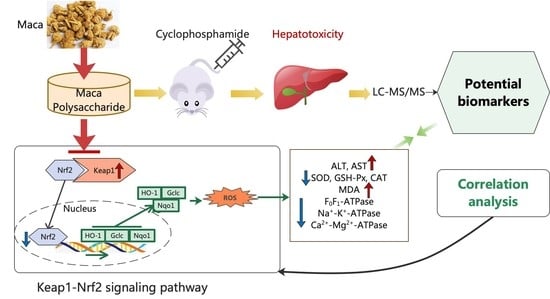Antioxidative and Energy Metabolism-Improving Effects of Maca Polysaccharide on Cyclophosphamide-Induced Hepatotoxicity Mice via Metabolomic Analysis and Keap1-Nrf2 Pathway
Abstract
:1. Introduction
2. Materials and Methods
2.1. Materials
2.2. Reagents
2.3. Animals
2.4. Experimental Design
2.5. Bodyweight and Daily Observation
2.6. Sample Collection
2.7. Histopathological Analysis of Livers
2.8. Assessment of Liver Function Transferases
2.9. Determination of Hepatic Oxidative Stress Markers
2.10. Determination of ATPases in Liver Tissue
2.11. Hepatic Metabolomic Analysis
2.11.1. Liver Sample Metabolite Extraction and QC Sample Preparation
2.11.2. LC-MS/MS Analysis
2.11.3. Data Preprocessing and Multivariate Data Analysis
2.11.4. Metabolite Identification
2.12. Quantitative Real-Time PCR Analysis
2.13. Determination of Protein Expression Level Using Western Blotting
2.14. Statistical Analysis
3. Results
3.1. Effects of Maca Polysaccharide on General Conditions and Body Weights of CYP-Treated Mice
3.2. Maca Polysaccharide Alleviates Liver Histopathological Changes Induced by CYP
3.3. Maca Polysaccharide Reduces the Levels of Serum Transaminase in CYP-Induced Hepatotoxicity Mice
3.4. Maca Polysaccharide Reduces Oxidative Stress
3.5. Effect of Maca Polysaccharide on the Mitochondrial Energy Metabolism in the Liver Tissues of CYP-Treated Mice
3.6. Hepatic Metabolomic Analysis Based on PCA and OPLS-DA
3.7. Screening and Identification for Potential Biomarkers
3.8. Metabolic Pathway of Potential Biomarkers
3.9. Correlation Analysis between Potential Biomarkers and Biochemical Indices
3.10. Maca Polysaccharide Activates Protective Antioxidant Mechanisms via Keap1-Nrf2 Signaling after Cyclophosphamide Chanllenge
4. Discussion
4.1. MP Alleviates Cyclophosphamide-Induced Hepatotoxicity in Mice by Ameliorating Oxidative Stress and Improving Energy Metabolism
4.2. MP Regulates the Potential Metabolic Markers and Pathways Associated with CYP-Induced Hepatotoxicity
4.3. Maca Polysaccharide Attenuates CYP-Induced Hepatotoxicity via Keap1-Nrf2 Antioxidative Pathway
5. Conclusions
Author Contributions
Funding
Institutional Review Board Statement
Acknowledgments
Conflicts of Interest
Abbreviations
| SOD | superoxide dismutase |
| CAT | catalase |
| LDH | lactate dehydrogenase |
| LPO | lipid peroxidation |
| MP | Maca polysaccharide |
| CYP | cyclophosphamide |
| ROS | reactive oxygen species |
| ALT | alanine aminotransferase |
| AST | aspartate transaminase |
| MDA | malondialdehyde |
| GSH-Px | glutathione peroxidase |
| Rha | rhamnose |
| Ara | arabinose |
| Glc | glucose |
| Gal | galactose |
| i.p. | intraperitoneal |
| NADH | nicotinamide adenine dinucleotide |
| QC | quality control |
| PCA | principal component analysis |
| OPLS-DA | orthogonal projection to latent structure discriminate analysis |
| VIP | variable importance in projection |
| KEGG | Kyoto Encyclopedia of Genes and Genomes |
| RT-qPCR | real-time fluorescence quantitative polymerase chain reaction |
| Nrf2 | nuclear factor (erythroid-derived 2)-like 2 |
| Keap1 | kelch-like ECH-associated protein 1 |
| HO-1 | heme oxygenase 1 |
| Gclc | glutamate cysteine ligase catalytic subunit |
| Nqo1 | NAD(P) H dehydrogenase quinone 1 |
| Cv | central veins |
| Vd | vacuolar degeneration |
| Fd | fatty degeneration |
| PLA2 | phospholipase A2 |
| HCY | homocysteine |
| PRPP | 5-phosphate-alpha-d-ribose 1-diphosphate |
References
- Gonzales, G.F.; Gonzales, C.; Gonzales-Castañeda, C. Lepidium meyenii(Maca): A Plant from the Highlands of Peru—From Tradition to Science. Complement. Med. Res. 2009, 16, 373–380. [Google Scholar] [CrossRef] [PubMed]
- Campos, D.; Chirinos, R.; Barreto, O.; Noratto, G.; Pedreschi, R. Optimized methodology for the simultaneous extraction of glucosinolates, phenolic compounds and antioxidant capacity from maca (Lepidium meyenii). Ind. Crop. Prod. 2013, 49, 747–754. [Google Scholar] [CrossRef]
- Piacente, S.; Carbone, V.; Plaza, A.; Zampelli, A.; Pizza, C. Investigation of the Tuber Constituents of Maca (Lepidium meyenii Walp.). J. Agric. Food Chem. 2002, 50, 5621–5625. [Google Scholar] [CrossRef] [PubMed]
- Suárez, S.; Oré, R.; Arnao, I.; Rojas, L.; Trabucco, J. Aqueous Lepidium meyenii Walp (Maca) extract and its role as an adaptogen, in an endurance animal model. An. Fac. Med. 2009, 70, 181–185. [Google Scholar] [CrossRef] [Green Version]
- Li, Y.; Xu, F.; Zheng, M.; Xi, X.; Cui, X.; Han, C. Maca polysaccharides: A review of compositions, isolation, therapeutics and prospects. Int. J. Biol. Macromol. 2018, 111, 894. [Google Scholar] [CrossRef] [PubMed]
- da Silva Leitão Peres, N.; Cabrera Parra Bortoluzzi, L.; Medeiros Marques, L.L.; Formigoni, M.; Fuchs, R.H.B.; Droval, A.A.; Reitz Cardoso, F.A. Medicinal effects of Peruvian Maca (Lepidium meyenii): A review. Food Funct. 2020, 11, 83–92. [Google Scholar] [CrossRef] [PubMed]
- Fei, W.; Hou, Y.; Yue, N.; Zhou, X.; Wang, Y.; Wang, L.; Li, A.; Zhang, J. The effects of aqueous extract of Maca on energy metabolism and immunoregulation. Eur. J. Med. Res. 2020, 25, 24. [Google Scholar] [CrossRef]
- Fei, W.-T.; Yue, N.; Li, A.-M.; Yu, S.-H.; Zhao, D.-P.; Zhu, Y.-L.; Wang, C.; Zhang, J.-J.; Wang, L.-Y. Immunomodulatory Effects of Lepidium meyenii Walp. Polysaccharides on an Immunosuppression Model Induced by Cyclophosphamide. J. Immunol. Res. 2022, 2022, 1210890. [Google Scholar] [CrossRef] [PubMed]
- Rehman, M.U.; Tahir, M.; Ali, F.; Qamar, W.; Lateef, A.; Khan, R.; Quaiyoom, A.; O-Hamiza, O.; Sultana, S. Cyclophosphamide-induced nephrotoxicity, genotoxicity, and damage in kidney genomic DNA of Swiss albino mice: The protective effect of Ellagic acid. Mol. Cell. Biochem. 2012, 365, 119–127. [Google Scholar] [CrossRef]
- Haubitz, M. Acute and long-ter toxicity of cyclophosphamide. Transplantation 2007, 19, 26. [Google Scholar]
- Kern, J.C.; Kehrer, J.P. Acrolein-induced cell death: A caspase-influenced decision between apoptosis and oncosis/necrosis. Chem. Interact. 2002, 139, 79–95. [Google Scholar] [CrossRef]
- Moghe, A.; Ghare, S.; Lamoreau, B.; Mohammad, M.; Barve, S.; McClain, C.; Joshi-Barve, S. Molecular Mechanisms of Acrolein Toxicity: Relevance to Human Disease. Toxicol. Sci. 2015, 143, 242–255. [Google Scholar] [CrossRef] [PubMed]
- Gutteridge, J.M. Lipid peroxidation and antioxidants as biomarkers of tissue damage. Clin. Chem. 1995, 41, 1819–1828. [Google Scholar] [CrossRef] [PubMed]
- Oyagbemi, A.A.; Omobowale, O.T.; Asenuga, E.R.; Akinleye, A.S.; Ogunsanwo, R.O.; Saba, A.B. Cyclophosphamide-induced Hepatotoxicity in Wistar Rats: The Modulatory Role of Gallic Acid as a Hepatoprotective and Chemopreventive Phytochemical. Int. J. Prev. Med. 2016, 7, 51. [Google Scholar] [CrossRef] [PubMed]
- Pu, X.; Fan, W.; Yu, S.; Li, Y.; Ma, X.; Liu, L.; Ren, J.; Zhang, W. Polysaccharides from Angelica and Astragalus exert hepatoprotective effects against carbon-tetrachloride-induced intoxication in mice. Can. J. Physiol. Pharmacol. 2015, 93, 39–43. [Google Scholar] [CrossRef] [PubMed]
- Mahmoud, A.M. Hesperidin protects against cyclophosphamide-induced hepatotoxicity by upregulation of PPARγ and abrogation of oxidative stress and inflammation. Can. J. Physiol. Pharmacol. 2014, 92, 717–724. [Google Scholar] [CrossRef] [PubMed]
- Dröge, W. Free Radicals in the Physiological Control of Cell Function. Physiol. Rev. 2002, 82, 47–95. [Google Scholar] [CrossRef] [PubMed] [Green Version]
- Zhang, L.; Zhao, Q.; Wang, L.; Zhao, M.; Zhao, B. Protective effect of polysaccharide from maca (Lepidium meyenii) on Hep-G2 cells and alcoholic liver oxidative injury in mice. Int. J. Biol. Macromol. 2017, 99, 63–70. [Google Scholar] [CrossRef]
- Zha, S.; Zhao, Q.; Chen, J.; Wang, L.; Zhang, G.; Zhang, H.; Zhao, B. Extraction, purification and antioxidant activities of the polysaccharides from Maca (Lepidium meyenii). Carbohydr. Polym. 2014, 111, 584–587. [Google Scholar] [CrossRef] [PubMed]
- Zhang, Y.; Han, Y.; He, J.; Ouyang, K.; Zhao, M.; Cai, L.; Zhao, Z.; Meng, W.; Chen, L.; Wang, W. Digestive properties and effects of Chimonanthus nitens Oliv polysaccharides on antioxidant effects in vitro and in immunocompromised mice. Int. J. Biol. Macromol. 2021, 185, 306–316. [Google Scholar] [CrossRef] [PubMed]
- Al Aboud, D.; Baty, R.S.; Alsharif, K.F.; Hassan, K.E.; Zhery, A.S.; Habotta, O.A.; Elmahallawy, E.K.; Amin, H.K.; Abdel Moneim, A.E.; Kassab, R.B. Protective efficacy of thymoquinone or ebselen separately against arsenic-induced hepatotoxicity in rat. Environ. Sci. Pollut. Res. Int. 2021, 28, 6195–6206. [Google Scholar] [CrossRef] [PubMed]
- Uchiyama, M.; Mihara, M. Determination of malonaldehyde precursor in tissues by thiobarbituric acid test. Anal. Biochem. 1978, 86, 271–278. [Google Scholar] [CrossRef]
- Paglia, D.E.; Valentine, W.N. Studies on the quantitative and qualitative characterization of erythrocyte glutathione peroxidase. J. Lab. Clin. Med. 1967, 70, 158–169. [Google Scholar] [PubMed]
- Flohé, L.; Otting, F. Superoxide dismutase assays. Methods Enzymol. 1984, 105, 93–104. [Google Scholar]
- Quabius, E.S.; Balm, P.H.; Wendelaar Bonga, S.E. Interrenal stress responsiveness of tilapia (Oreochromis mossambicus) is impaired by dietary exposure to PCB 126. Gen. Comp. Endocrinol. 1997, 108, 472–482. [Google Scholar] [CrossRef] [Green Version]
- Zhou, W.; Liang, H.; Zhang, X. Erythrocyte damage of crucian carp (Carassius auratus) caused by microcystin-LR: In vitro study. Fish Physiol. Biochem. 2012, 38, 849–858. [Google Scholar] [CrossRef]
- Zharova, T.V.; Kozlovsky, V.S.; Grivennikova, V.G. Interaction of Venturicidin and Fo·F1-ATPase/ATP Synthase of Tightly Coupled Subbacterial Particles of Paracoccus denitrificans in Energized Membranes. Biochemistry 2022, 87, 742–751. [Google Scholar] [CrossRef] [PubMed]
- Zhou, B.; Ma, C.; Ren, X.; Xia, T.; Li, X. LC-MS/MS-based metabolomic analysis of caffeine-degrading fungus Aspergillus sydowii during tea fermentation. J. Food Sci. 2020, 85, 477–485. [Google Scholar] [CrossRef] [PubMed]
- Kanehisa, M.; Sato, Y.; Kawashima, M.; Furumichi, M.; Tanabe, M. KEGG as a reference resource for gene and protein annotation. Nucleic Acids Res. 2015, 44, D457–D462. [Google Scholar] [CrossRef] [PubMed] [Green Version]
- Hirano, S. Western blot analysis. Methods Mol. Biol. 2012, 926, 87–97. [Google Scholar]
- Ilghami, R.; Barzegari, A.; Mashayekhi, M.R.; Letourneur, D.; Crepin, M.; Pavon-Djavid, G. The conundrum of dietary antioxidants in cancer chemotherapy. Nutr. Rev. 2019, 78, 65–76. [Google Scholar] [CrossRef]
- Wang, K.; Wan, Z.; Ou, A.; Liang, X.; Guo, X.; Zhang, Z.; Wu, L.; Xue, X. Monofloral honey from a medical plant, Prunella Vulgaris, protected against dextran sulfate sodium-induced ulcerative colitis via modulating gut microbial populations in rats. Food Funct. 2019, 10, 3828–3838. [Google Scholar] [CrossRef]
- Koh, H.; Park, G.-S.; Shin, S.-M.; Park, C.E.; Kim, S.; Han, S.J.; Pham, H.Q.; Shin, J.-H.; Lee, D.-W. Mitochondrial Mutations in Cholestatic Liver Disease with Biliary Atresia. Sci. Rep. 2018, 8, 905. [Google Scholar] [CrossRef]
- Zhang, X.; Liu, W.; Niu, X.; An, L. Systemic administration of catalpol prevents d-galactose induced mitochondrial dysfunction in mice. Neurosci. Lett. 2010, 473, 224–228. [Google Scholar] [CrossRef]
- Paradies, G.; Petrosillo, G.; Paradies, V.; Ruggiero, F.M. Mitochondrial dysfunction in brain aging: Role of oxidative stress and cardiolipin. Neurochem. Int. 2011, 58, 447–457. [Google Scholar] [CrossRef] [PubMed]
- Benzi, G.; Gorini, A.; Arnaboldi, R.; Ghigini, B.; Villa, R.F. Synaptosomal non-mitochondrial ATPase activities: Age-related alterations by chronic normobaric intermittent hypoxia. Neurochem. Int. 1994, 25, 61–67. [Google Scholar] [CrossRef]
- Chiang, D.-H.; Wei, J.-W. Effects of calcium antagonists on (Na+ + K+)-ATPase, Mg2+-ATPase and Ca2+-ATPase activities of rat cortical synaptosomes. Gen. Pharmacol. Vasc. Syst. 1987, 18, 563–567. [Google Scholar] [CrossRef]
- Ponziani, F.R.; Pecere, S.; Gasbarrini, A.; Ojetti, V. Physiology and pathophysiology of liver lipid metabolism. Expert Rev. Gastroenterol. Hepatol. 2015, 9, 1055–1067. [Google Scholar] [CrossRef] [PubMed]
- Luo, Y.; Gao, F.; Chang, R.; Zhang, X.; Zhong, J.; Wen, J.; Wu, J.; Zhou, T. Metabolomics based comprehensive investigation of Gardeniae Fructus induced hepatotoxicity. Food Chem. Toxicol. 2021, 153, 112250. [Google Scholar] [CrossRef]
- Bo, L.; Liu, Y.; Jia, S.; Liu, Y.; Zhang, M.; Li, S.; Zhao, X.; Sun, C. Metabonomics analysis of quercetin against the nephrotoxicity of acrylamide in rats. Food Funct. 2018, 9, 5965–5974. [Google Scholar] [CrossRef] [PubMed]
- Murakami, M.; Taketomi, Y.; Miki, Y.; Sato, H.; Hirabayashi, T.; Yamamoto, K. Recent progress in phospholipase A2 research: From cells to animals to humans. Prog. Lipid Res. 2010, 50, 152–192. [Google Scholar] [CrossRef] [PubMed]
- Ma, C.; Bi, K.; Su, D.; Ji, W.; Zhang, M.; Fan, X.; Wang, C.; Chen, X. Serum and kidney metabolic changes of rat nephrotoxicity induced by Morning Glory Seed. Food Chem. Toxicol. 2010, 48, 2988–2993. [Google Scholar] [CrossRef]
- Le, T.T.; Ziemba, A.; Urasaki, Y.; Hayes, E.; Brotman, S.; Pizzorno, G. Disruption of uridine homeostasis links liver pyrimidine metabolism to lipid accumulation. J. Lipid Res. 2013, 54, 1044–1057. [Google Scholar] [CrossRef]
- Paulusma, C.C.; Lamers, W.H.; Broer, S.; van de Graaf, S.F. Amino acid metabolism, transport and signalling in the liver revisited. Biochem. Pharmacol. 2022, 201, 115074. [Google Scholar] [CrossRef]
- Sim, W.-C.; Yin, H.-Q.; Choi, H.-S.; Choi, Y.-J.; Kwak, H.C.; Kim, S.-K.; Lee, B.-H. L-Serine Supplementation Attenuates Alcoholic Fatty Liver by Enhancing Homocysteine Metabolism in Mice and Rats. J. Nutr. 2014, 145, 260–267. [Google Scholar] [CrossRef] [Green Version]
- Cairns, R.A.; Harris, I.S.; Mak, T.W. Regulation of cancer cell metabolism. Nat. Rev. Cancer 2011, 11, 85–95. [Google Scholar] [CrossRef] [PubMed] [Green Version]
- Sherif, I.O. The effect of natural antioxidants in cyclophosphamide-induced hepatotoxicity: Role of Nrf2/HO-1 pathway. Int. Immunopharmacol. 2018, 61, 29–36. [Google Scholar] [CrossRef] [PubMed]
- Abd El-Twab, S.M.; Hozayen, W.G.; Hussein, O.E.; Mahmoud, A.M. 18beta-Glycyrrhetinic acid protects against methotrexate-induced kidney injury by up-regulating the Nrf2/ARE/HO-1 pathway and endogenous antioxidants. Ren. Fail. 2016, 38, 1516–1527. [Google Scholar] [CrossRef] [Green Version]
- Yu, C.; Xiao, J.-H. The Keap1-Nrf2 System: A Mediator between Oxidative Stress and Aging. Oxidative Med. Cell. Longev. 2021, 2021, 6635460. [Google Scholar] [CrossRef]
- Bryan, H.K.; Olayanju, A.; Goldring, C.E.; Park, B.K. The Nrf2 cell defence pathway: Keap1-dependent and -independent mechanisms of regulation. Biochem. Pharmacol. 2013, 85, 705–717. [Google Scholar] [CrossRef] [Green Version]
- Wu, T.; Li, J.; Li, Y.; Song, H. Antioxidant and Hepatoprotective Effect of Swertiamarin on Carbon Tetrachloride-Induced Hepatotoxicity via the Nrf2/HO-1 Pathway. Cell Physiol. Biochem. 2017, 41, 2242–2254. [Google Scholar] [CrossRef]
- Zhao, X.J.; Yu, H.W.; Yang, Y.Z.; Wu, W.Y.; Chen, T.Y.; Jia, K.K.; Kang, L.L.; Jiao, R.Q.; Kong, L.D. Polydatin prevents fructose-induced liver inflammation and lipid deposition through increasing miR-200a to regulate Keap1/Nrf2 pathway. Redox Biol. 2018, 18, 124–137. [Google Scholar] [CrossRef] [PubMed]
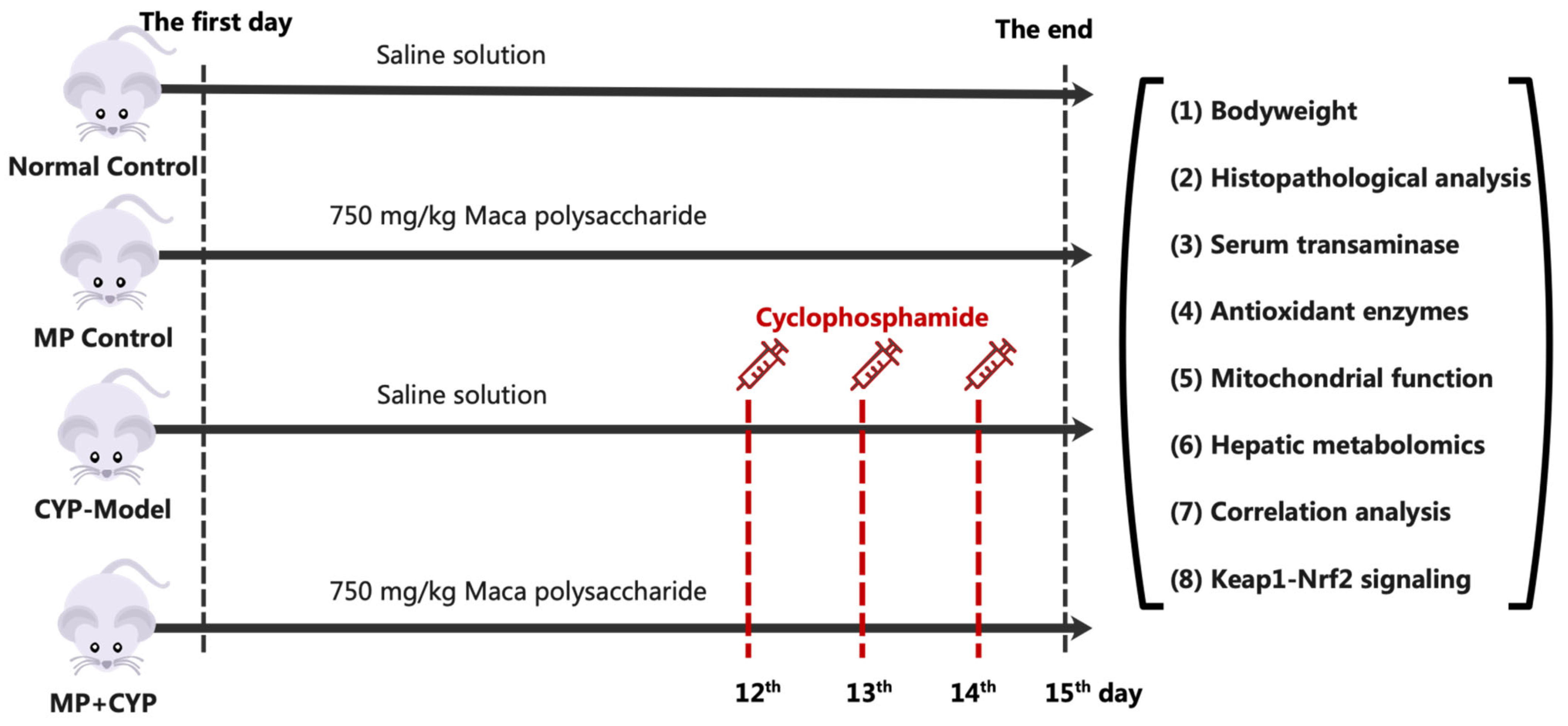

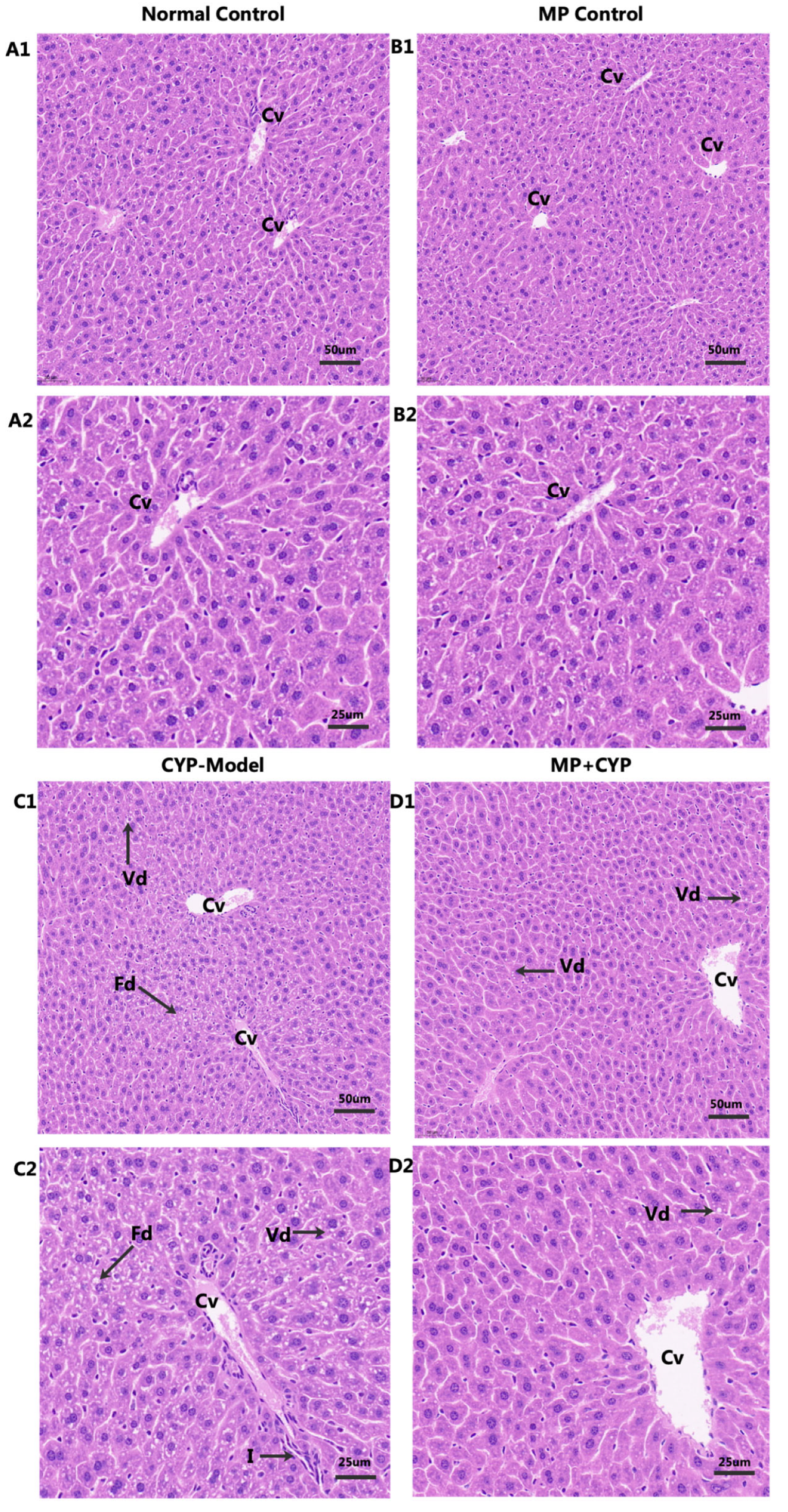


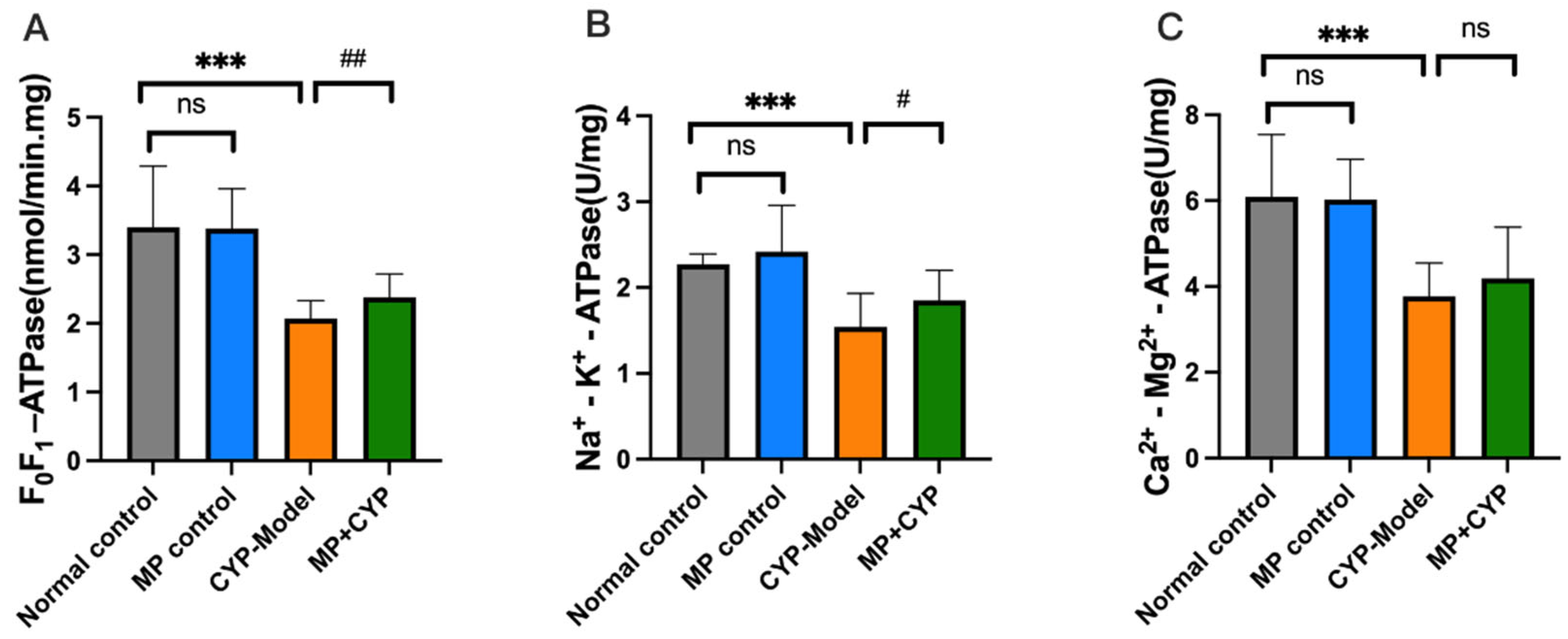
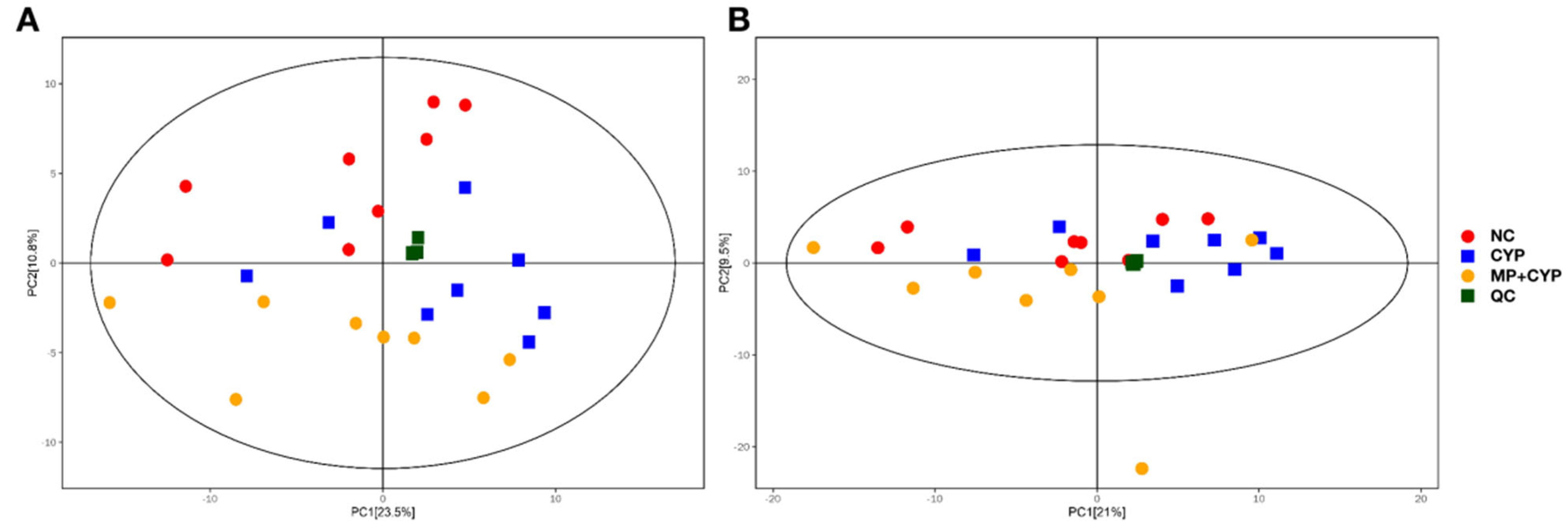
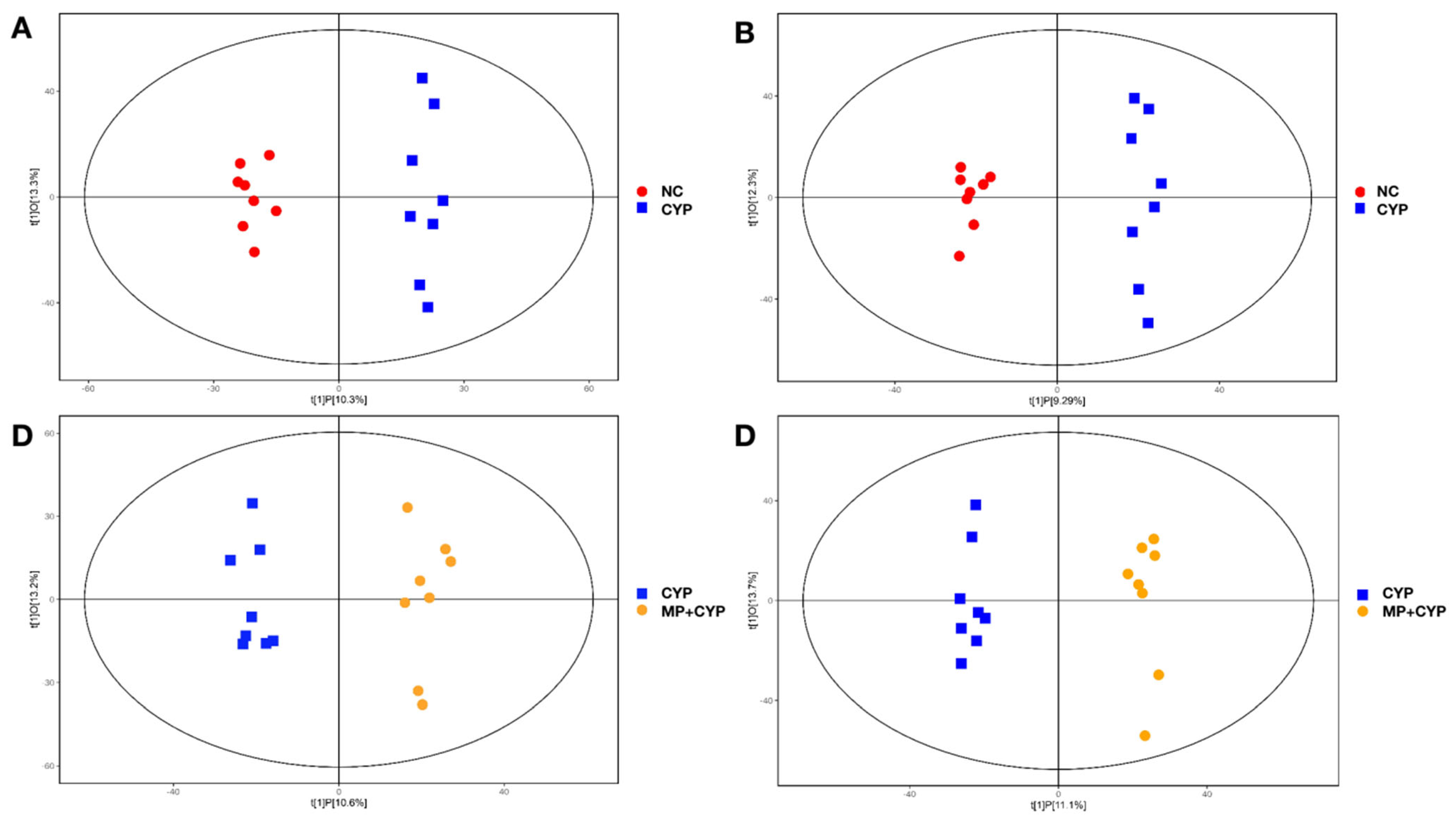

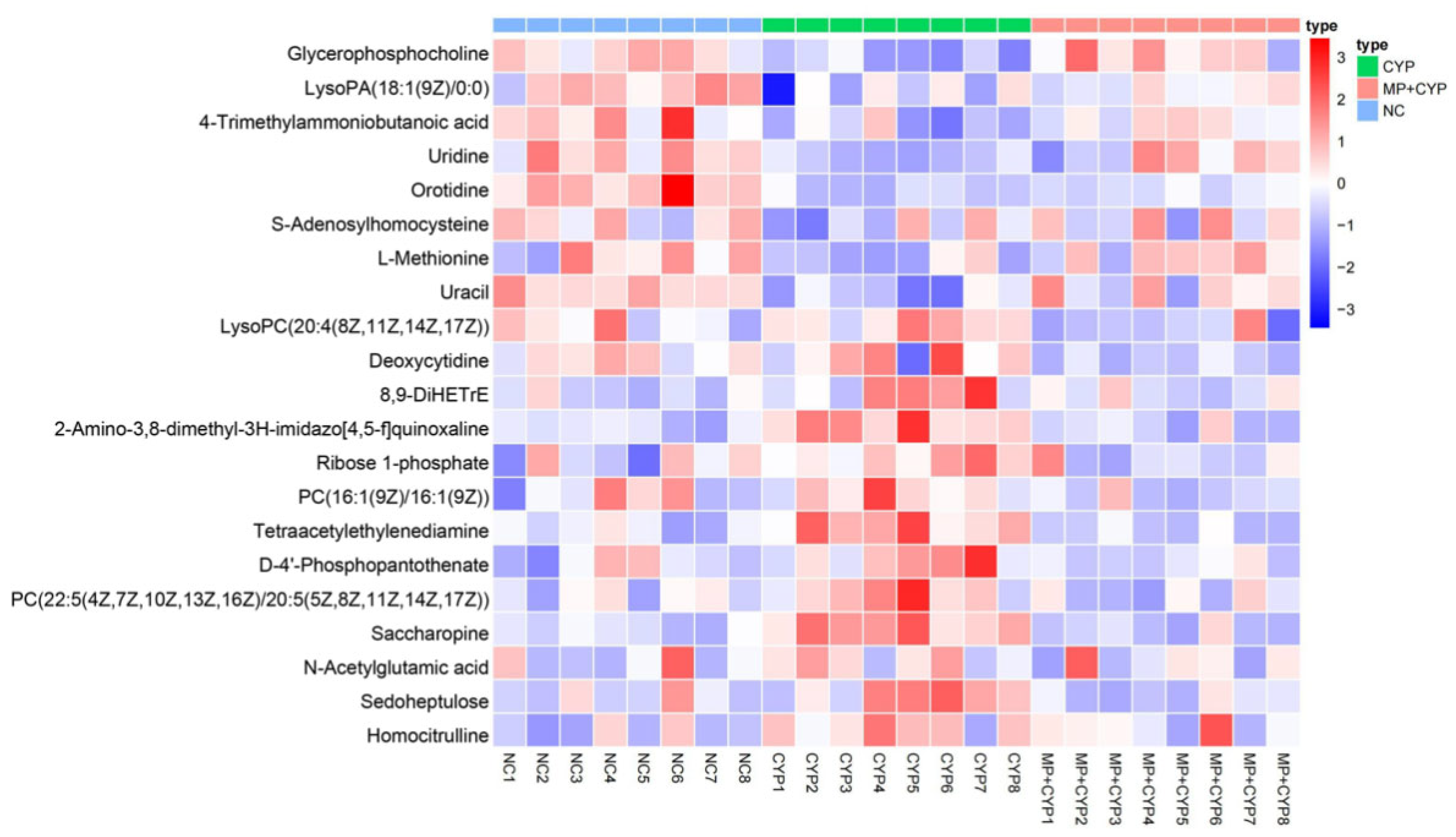
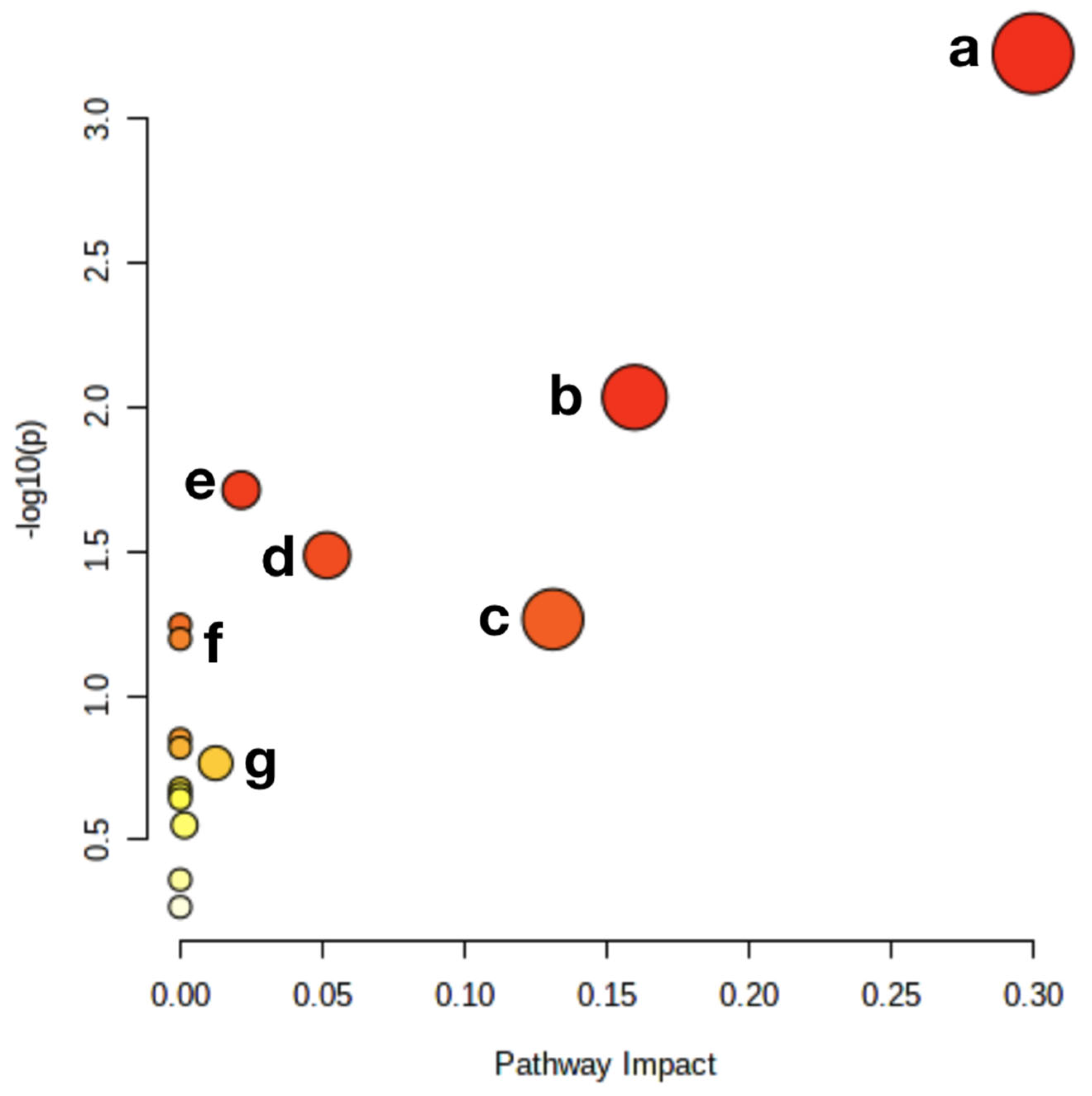
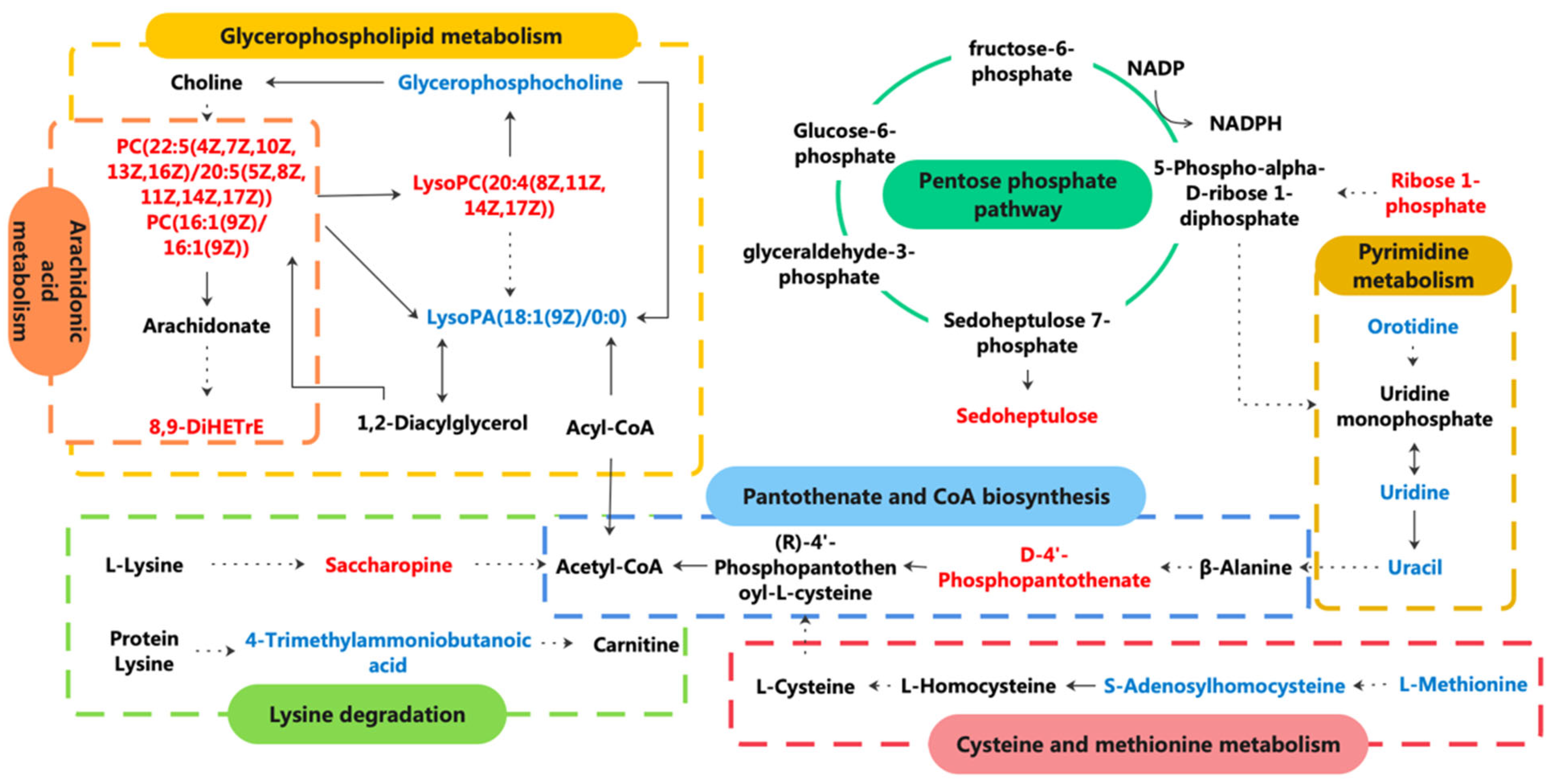
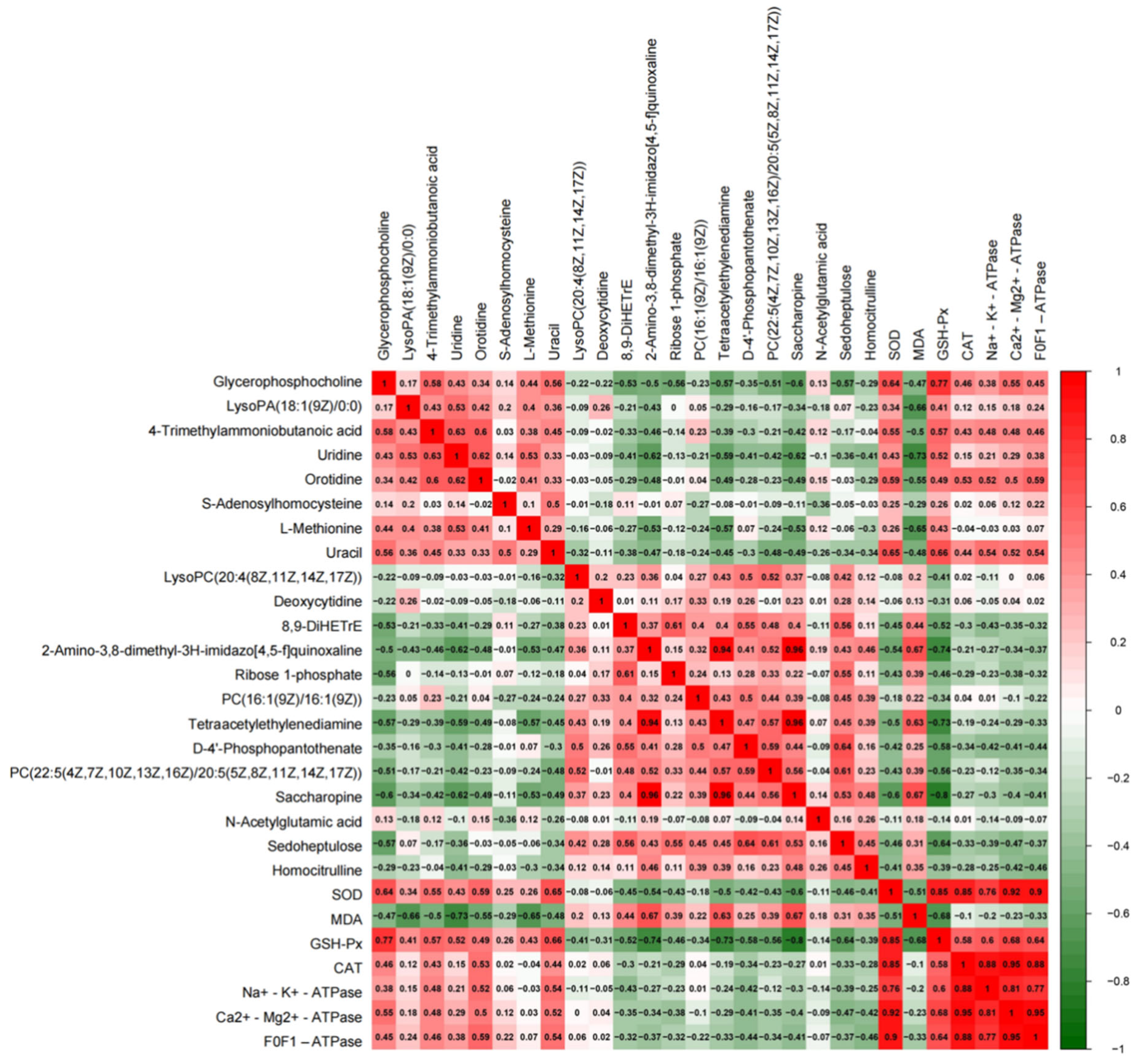
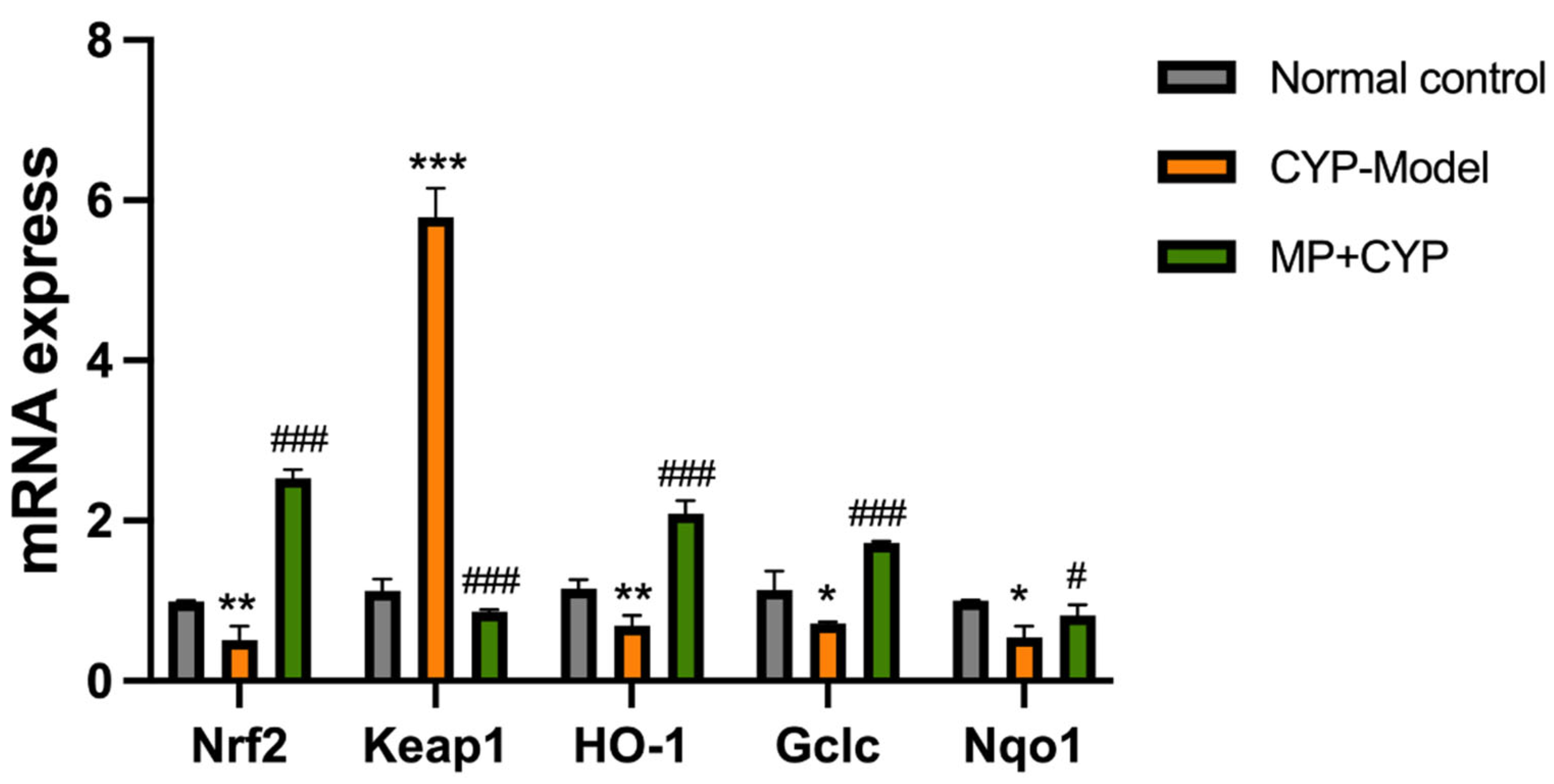

| Genes | Forward (5′–3′) | Reverse (5′–3′) |
|---|---|---|
| Nrf2 | CCTTTGGAGGCAAGACATAGATC | CATCTACAAATGGGAATGTCTCTG |
| Keap1 | GAGATATGAGCCAGAGCGGGA | AACTGGTCCTGCCCATCGTAG |
| HO-1 | AACTTTCAGAAGGGTCAGGTGTC | CTCCTCAGGGAAGTAGAGTGGG |
| Gclc | CTGTAGATGATAGAACACGGGAGG | GAGATGAGCAACGTGCTGTGC |
| Nqo1 | GCGAGAAGAGCCCTGATTGT | AGATGACTCGGAAGGATACTGAAA |
| GAPDH | CCTCGTCCCGTAGACAAAATG | TGAGGTCAATGAAGGGGTCGT |
| No. | Differential Metabolites | Mode | CYP vs. NC | MP+CYP vs. CYP | ||||
|---|---|---|---|---|---|---|---|---|
| VIP | FC | Trend | VIP | FC | Trend | |||
| 1 | Glycerophosphocholine | ESI+ | 1.66 | 0.80 | ↓ * | 1.08 | 1.08 | ↑ * |
| 2 | LysoPA(18:1(9Z)/0:0) | ESI− | 1.2 | 0.71 | ↓ * | 1.69 | 1.27 | ↑ * |
| 3 | 4-Trimethylammoniobutanoic acid | ESI+ | 1.11 | 0.72 | ↓ * | 1.60 | 1.42 | ↑ * |
| 4 | Uridine | ESI+ | 2.07 | 0.82 | ↓ ** | 1.29 | 1.18 | ↑ * |
| 5 | Orotidine | ESI− | 2.22 | 0.71 | ↓ *** | 1.37 | 1.37 | ↑ * |
| 6 | S-Adenosylhomocysteine | ESI+ | 2.05 | 0.75 | ↓ * | 1.06 | 1.30 | ↑ * |
| 7 | L-Methionine | ESI+ | 1.58 | 0.88 | ↓ * | 1.70 | 1.17 | ↑ * |
| 8 | Uracil | ESI− | 1.82 | 1.24 | ↓ * | 1.12 | 1.02 | ↑ * |
| 9 | LysoPC(20:4(8Z,11Z,14Z,17Z)) | ESI+ | 1.95 | 1.67 | ↑ * | 1.71 | 0.64 | ↓ * |
| 10 | Deoxycytidine | ESI− | 1.84 | 0.76 | ↑ * | 1.20 | 0.76 | ↓ * |
| 11 | 8,9-DiHETrE | ESI− | 1.59 | 1.63 | ↑ * | 1.16 | 0.70 | ↓ * |
| 12 | 2-Amino-3,8-dimethyl-3H-imidazo [4,5-f]quinoxaline | ESI+ | 2.45 | 2.24 | ↑ *** | 2.37 | 0.43 | ↓ *** |
| 13 | Ribose 1-phosphate | ESI− | 1.47 | 1.33 | ↑ * | 1.58 | 0.74 | ↓ * |
| 14 | PC(16:1(9Z)/16:1(9Z)) | ESI+ | 1.19 | 2.23 | ↑ * | 1.57 | 0.36 | ↓ * |
| 15 | Tetraacetylethylenediamine | ESI+ | 2.14 | 2.25 | ↑ *** | 2.56 | 0.35 | ↓ *** |
| 16 | D-4′-Phosphopantothenate | ESI+ | 1.38 | 1.53 | ↑ * | 1.67 | 0.62 | ↓ * |
| 17 | PC(22:5(4Z,7Z,10Z,13Z,16Z)/20:5(5Z,8Z,11Z,14Z,17Z)) | ESI+ | 1.45 | 1.29 | ↑ * | 1.75 | 0.75 | ↓ * |
| 18 | Saccharopine | ESI− | 2.55 | 2.16 | ↑ *** | 2.47 | 0.40 | ↓ *** |
| 19 | N-Acetylglutamic acid | ESI− | 1.77 | 1.27 | ↑ * | 2.33 | 0.68 | ↓ *** |
| 20 | Sedoheptulose | ESI+ | 1.27 | 1.79 | ↑ * | 1.99 | 0.42 | ↓ ** |
| 21 | Homocitrulline | ESI+ | 1.71 | 1.36 | ↑ * | 1.77 | 0.66 | ↓ * |
Publisher’s Note: MDPI stays neutral with regard to jurisdictional claims in published maps and institutional affiliations. |
© 2022 by the authors. Licensee MDPI, Basel, Switzerland. This article is an open access article distributed under the terms and conditions of the Creative Commons Attribution (CC BY) license (https://creativecommons.org/licenses/by/4.0/).
Share and Cite
Fei, W.; Zhang, J.; Yu, S.; Yue, N.; Ye, D.; Zhu, Y.; Tao, R.; Chen, Y.; Chen, Y.; Li, A.; et al. Antioxidative and Energy Metabolism-Improving Effects of Maca Polysaccharide on Cyclophosphamide-Induced Hepatotoxicity Mice via Metabolomic Analysis and Keap1-Nrf2 Pathway. Nutrients 2022, 14, 4264. https://doi.org/10.3390/nu14204264
Fei W, Zhang J, Yu S, Yue N, Ye D, Zhu Y, Tao R, Chen Y, Chen Y, Li A, et al. Antioxidative and Energy Metabolism-Improving Effects of Maca Polysaccharide on Cyclophosphamide-Induced Hepatotoxicity Mice via Metabolomic Analysis and Keap1-Nrf2 Pathway. Nutrients. 2022; 14(20):4264. https://doi.org/10.3390/nu14204264
Chicago/Turabian StyleFei, Wenting, Jianjun Zhang, Shuhui Yu, Na Yue, Danni Ye, Yingli Zhu, Ran Tao, Yan Chen, Yawen Chen, Aimin Li, and et al. 2022. "Antioxidative and Energy Metabolism-Improving Effects of Maca Polysaccharide on Cyclophosphamide-Induced Hepatotoxicity Mice via Metabolomic Analysis and Keap1-Nrf2 Pathway" Nutrients 14, no. 20: 4264. https://doi.org/10.3390/nu14204264




